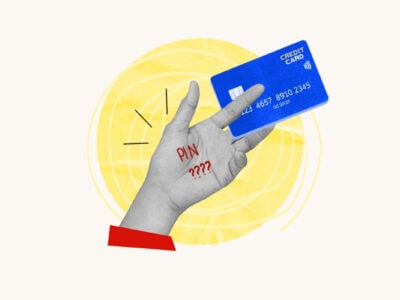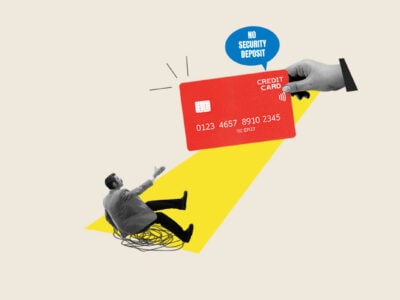If you ever use your credit card to shop online—something that’s nearly universal these days—you’re at least somewhat familiar with the concept of a credit card security code. Most merchants require you to provide this number because it protects you from identity theft and fraud.
Read to learn more about what exactly your credit card security code is, how it works, and where to find it on every major type of credit card.
Table of Contents
What is a credit card security code?
A credit card security code is a short number (3 or 4 digits) located somewhere on your physical credit card—often on the back. It’s different from your credit card number, which is a much longer string of digits that identifies your card.
As the name suggests, your security code is meant to provide an additional layer of protection to keep you safe from identity thieves and fraudsters.
When do you have to provide your security code?
As mentioned, when you buy something remotely—either online or over the phone—you’ll usually have to provide your security code (along with several other key pieces of information, including your credit card number and your card’s expiration date).
You don’t need to provide your security code when you use your card in person. It’s only meant for “card-not-present” (aka remote) transactions.
Where to find your credit card security code
The exact location of your CVV depends on what credit card network your card is on (Mastercard, Visa, Discover, or American Express).
The table and illustrations below show where you can find the CVV on cards from all four networks, as well as how many digits it will be.
Security Codes by Credit Card Network
| Credit card network | CVV digits | Location of CVV |
|---|---|---|
| Visa | 3 | Back of card, to the right of your signature |
| Mastercard | 3 | Back of card, to the right of your signature |
| Discover | 3 | Back of card, to the right of your signature (in a small box) |
| American Express | 4 | Front of card on the right side (usually above your credit card number, although this varies) |
This graphic shows the exact location of the security code on a typical card from each network:
Credit Card Security Code Locations

It’s possible your card won’t be laid out exactly like the ones in this image (different credit card issuers sometimes design their cards a bit differently) but the security code should be in basically the same place.
Other terms for credit card security codes
You may sometimes see your credit card issuer refer to your security code by other acronyms. Here’s what they are and what they stand for:
- CSC: Card security code
- CVD: Card verification data
- CVC/CVC2: Card verification code (1st and 2nd generation)
- CVV/CVV2: Card verification value (2nd generation)
- CVVC: Card verification value code
- CID: Card identification number
- V-Code: Verification code
- SPC: Signature panel code
Don’t worry about the terminology your credit card company uses—these are pieces of industry jargon that all refer to the same thing.
How does your credit card security code keep you safe?
The idea behind security codes is simple. This code is printed on your card, nowhere else, so when you use your card remotely, it lets the seller confirm that it’s really you—the actual cardholder—instead of a hacker who managed to steal your credit card number.
Merchants aren’t allowed to store your security code
Having a CVV doesn’t provide complete security. If someone manages to steal it in addition to your credit card number, they can still make fraudulent purchases on your card.
However, stealing a security code is quite difficult, thanks to the Payment Card Industry Data Security Standard (PCI DSS), a set of security requirements that the major credit card networks created in 2004.
All merchants that handle credit cards must comply with the PCI DSS. Per its terms, merchants cannot store your security code once they complete a transaction (even when you sign up for recurring charges, like when you buy a subscription to an online service).
This means that even if your information is compromised in a data breach, the thieves won’t get your CVV and won’t be able to make fraudulent purchases with your card from any vendors that require security codes. 1
How to keep your credit card information safe
The point of your security code is that only you know it. If anyone else gets access to it, it’s not doing much to protect you anymore.
To keep your CVV safe (along with your credit card number and all of your other info), take the following steps.
1. Be careful when you shop online
Follow all the usual best practices when you shop online.
- Buy from reputable retailers: Large, well-known retailers are more likely to store your credit card info securely than smaller ones. Again, retailers are never supposed to store your security code at all, but major companies are more likely to comply with this requirement.
- Use a secure connection: Before providing your credit card info to an online merchant, check the URL bar in your browser and make sure the URL starts with “https” (as opposed to “http”). This indicates that the website is secure. Also, if you’re connected to a Wi-Fi network, make sure that it’s password-protected and private. Don’t provide your credit card details (or any other sensitive information) when you’re on a public network, e.g., in an airport or cafe.
- Watch out for spoofing: Be on the lookout for websites or emails that are “spoofing” major retailers, i.e., pretending to be them. For instance, if you receive an email that claims to be from Amazon, verify that the website domain name is correct before you enter any personal information.
2. Don’t share your credit card information
Be very cautious when giving out your credit card info. Never give it to anyone who called you over the phone, no matter who they claim to be. If you’re interested in what they’re selling, hang up, verify their company’s phone number, then call back.
Don’t lend your credit card to anyone (even a close friend), and don’t take pictures of it. If you store your credit card information on your mobile phone, make sure that it has a secure passcode and that you don’t leave it unlocked.
3. Keep an eye on your credit reports and credit card statements
Monitor your credit card statements for suspicious transactions. Do the same with your credit reports, which you can obtain every year for free from AnnualCreditReport.com.
If your credit card balance suddenly spikes or any debts appear that you don’t recognize, contact your credit card issuer right away. They’ll cancel your card and send you a new one (with a new security code).






